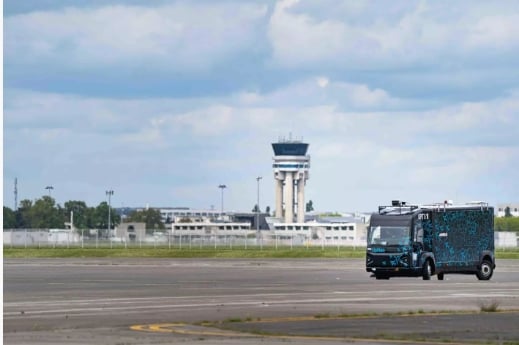Airbus has unveiled an innovative electric truck demonstrator UpNext fitted with basic A350 airliner controls at the VivaTech technology event, showcasing its efforts to develop automated taxiing systems that can make airports safer.


The converted truck, equipped with sensors and onboard computers, can be driven normally or have the aircraft systems take control, navigating through obstacles and warning lines to reach a specific location.
The development of automated taxiing systems is a critical step towards reducing the risk of accidents on the ground, particularly in congested airports. The technology has the potential to revolutionize the way aircraft are moved around airports, reducing the risk of human error and increasing efficiency.
The collaboration between Airbus and Israeli electric vehicle maker Ree Automotive is an important step towards advancing this technology, and the project’s focus on slow-speed ramp incidents is a significant area of concern for the aviation industry.
The Truck with Airliner Cockpit
The electric truck converted by Airbus for the VivaTech event, Europe’s largest technology fair, can be driven manually or controlled by aircraft systems. Sensors monitor warning lines and obstacles, while onboard computers navigate the vehicle to a specific destination, adjusting speed and braking as needed.


Airbus is careful not to link this research to any specific incidents, though comparisons are inevitable, such as the fiery collision in January between a landing A350 and a coast guard plane that appeared to have strayed onto a Tokyo runway.
Another investigation was launched last month after a Virgin Atlantic jet’s wingtip collided with a stationary British Airways plane. In February, U.S. regulators announced an inquiry into a collision between two JetBlue aircraft at Boston Logan Airport.
Airbus aims to demonstrate through this vehicle, which maneuvers through a side alley at the Paris exhibition center hosting tech giants and startups at VivaTech, how automation can safely navigate $100-million-plus jets through increasingly crowded airports.
Though slow-speed ramp incidents are rarely fatal, they pose a growing challenge for airlines, airports, insurers, and passengers due to the delays they cause.


Airbus UpNext has collaborated with Israeli electric vehicle maker Ree Automotive as part of its three-year “Optimate” project to develop the hybrid research platform. The plane-truck will be tested at operational airports and could set the stage for future tests on an A350-1000 aircraft.
If successful, the project could influence future aircraft design, but certifying new systems remains a significant challenge. Regardless, pilots will continue to play a crucial role. While Airbus jets already use automation to reduce pilot error, the current software is not autonomous and behaves only in predictable ways.
Outfitted with 3D-mapping LiDAR sensors, the research vehicle might explore advanced automation levels in the future, though Airbus states it has no plans to implement full autonomy in jetliners. The potential of LiDAR is gaining attention, especially after severe turbulence this week caused a Singapore Airlines flight incident, resulting in one passenger’s death due to a suspected heart attack and numerous injuries. Boeing began testing LiDAR in 2018, with experts hoping it can detect unstable air currents that traditional radar systems miss.
Written by Alius Noreika

